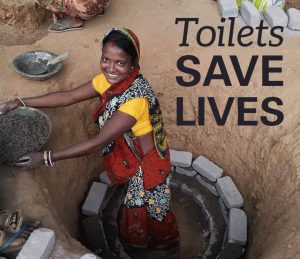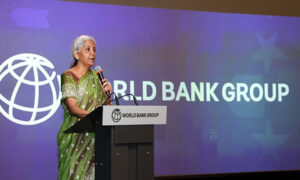
Source: Ministry of Drinking Water and Sanitation
As the Swachh Bharat Mission completed its fourth year, the government, corporate, international institutions, social enterprises, NGOs, religious groups, schools, hospitals, citizens and many more contributed and still contributing in a wide range of activities related to the sanitation in India. All such initiatives are shaping the sanitation economy in India. The sanitation economy is thriving and its prospect seems very promising. The Sanitation Economy is estimated at $62 billion market annually in India alone by 2021.
According to the World Bank, more than 520 million in India were defecating in the open – the highest number in the world. It was a staggering figure.
In 2014, Narendra Modi, Prime Minister of India, launched the Swachh Bharat Mission(Clean India Mission) on the Gandhi Jayanti and set the target of the open defecation free India by 2nd October 2019. The Mission was bifurcated in two parts namely Swachh Bharat Mission (Rural) and Swachh Bharat Mission (Urban). As names suggest, two line ministries namely the Ministry of Drinking Water and Sanitation and the Ministry of Urban Developed roped in to handle the all set of activities related to the Mission. Since then, the Union Government started a series of interventions in the domain of sanitation. If a government launches a scheme at the national level, it infuses a huge amount of money for a wide range of activities. It attracts various players from companies to social enterprises and celebrities though their intentions varies.
As India is geographically wide and vast, a mammoth intervention like the Clean India Mission requires engagement of various players like corporate, international institutions, social enterprises, NGOs, research & consultancy, celebrators, citizens and many more.
Swacch Bharat: Key Activities
It’s worthwhile to mention that Swachh Bharat Mission is not first intervention in India which focuses on the WASH issues. India had several programmes like the Nirman Bharat Abhiyaan, Total Sanitation Campaign and Central Rural Sanitation Program (CRSP). In this backdrop, the government claims that the rural sanitation coverage of India has now risen to 85 per cent. Through mobilization of rural communities, 7.4 crore toilets have been built across rural India, and as an outcome, over 3.8 lakh villages and 391 districts have been declared Open Defecation Free (ODF). Shedding light on the Mission, Bill Gates, Principal Founder, Microsoft stated, “Nearly three years ago, Indian Prime Minister Narendra Modi made one of the boldest comments on public health that I have ever heard from an elected official. It’s still having a big impact today.” On the other hand, Jim Yong Kim, World Bank President said, “The Swachh Bharat Mission can be a game-changer because good sanitation practices can help address malnutrition. I look forward to learning from India’s experience.”
The Mission has following components:
(i) Construction of Household Toilets
(ii) Community and Public Toilets
(iii) Solid Waste Management
(iv) Information, Education & Communication (IEC) and Public Awareness
(v) Capacity Building and Administrative & Office Expenses (A&OE)
Source: Press Information Bureau(PIB)
Credit Financing: It is mentioned that around 1.8 million sanitation loans have been disbursed with a capital mobalisation of USD 340 million. There are various forms of credit financing namely Self Help Groups (SHGs), Micro Financing Institutions and Commercial Banks.
According to the government communiqué, 76 union ministries have earmarked funds in their budget allocation for carrying out the cleanliness activities. As part of the annual action plan, they roll out Swachhta Action Plans for India.
In order to channelize the corporate and philanthropic contributions, the Government created the Swachh Bharat Kosh (SBK) under the Ministry of Finance. According to the government communiqué, the SBK received USD 118 Million in the last three years. Apart from this, many corporate run their own sanitation interventions. It is noted that many of corporate institute sanitation interventions in strategically important sectors.
In India, the Corporate Social Responsibility (CSR) has emerged as a buzz word after the New Company Act 2013. In 2014, the new government came into power and started the Swachh Bharat Mission. It realized that the government can moblise the CSR resource towards the Cleanliness drive and underlined its benefits. Encouraged by such clarion call from a new government, the corporate ventured to engage in the cleanliness drive.
Another important things which influenced it is the Sustainable Development Goals (SDGs). The United Nations instituted a comprehensive development goals which is known the SDGs. Under the SDG 6, it postulated that achieve universal and equitable access to safe and affordable drinking water for all by 2030.
In this backdrop, the Toilet Board Coalition published a thought piece titled The Sanitation Economy in India in November 2017. This study has been produced in collaboration with Tata Strategic Management Group (TSMG).
The Sanitation Economy Market Estimates 2017-2021
| 2017 | 2021 | Share of Market | |
| Sanitation Economy | $32 Billion | $62 Billion | |
| Toilet Economy | $14 Billion | $31 Billion | 50% |
| Circular Sanitation Economy | $14 Billion | $25 Billion | 40% |
| Smart Sanitation Economy | $4 Billion | $6 Billion | 10% |
Source: The Sanitation Economy in India, The Toilet Board Coalition
SBM-G Achievements in 4 years:
- Sanitation coverage increased from 39% to 93%
- 85 million toilets have been built by households
- 450,000 of 600,000 villages are now ODF
- Out of 699 districts 460 are ODF
- 450,000 grassroots motivators, swachhagrahis are stationed in villages
Source: Ministry of Drinking Water and Sanitation
In this backdrop, the leading organization started several initiatives for mapping of the thriving sanitation economy. One of them is the Economics of Sanitation Initiative. It was launched in 2007 as a response by the Water and Sanitation Program to address major gaps in evidence among developing countries on the economic aspects of sanitation. It’s a multi-country initiative of the Water and Sanitation Program (WSP). India is emerging a marketplace for various kinds of players namely corporate, startups and social enterprises. It acts as an effective tool to convince the decision makers and visionary leaders to take action.


















